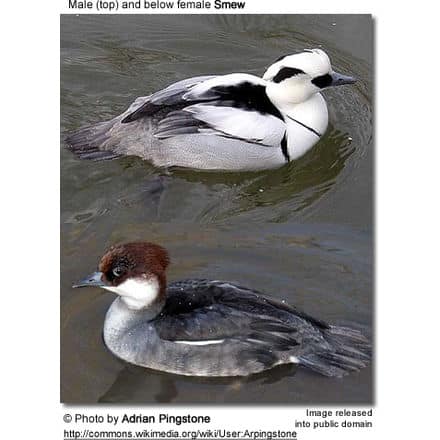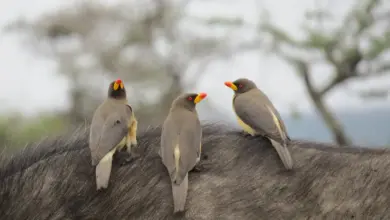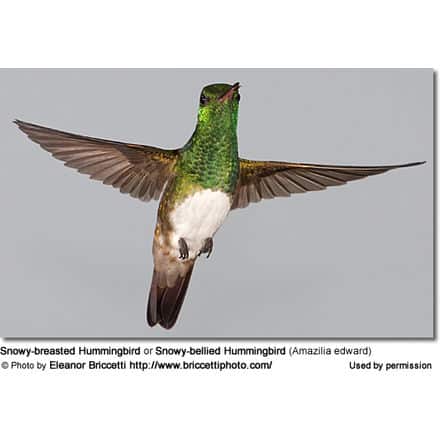Smew (Mergellus albellus)
The Smews (Mergellus albellus) is a small duck which is intermediate between the mergansers and the goldeneyes, and has interbred with the Common Goldeneye. It is the only member of the genus Mergellus (Selby, 1840).
The Smew is one of the species to which the Agreement on the Conservation of African-Eurasian Migratory Waterbirds (AEWA) applies.
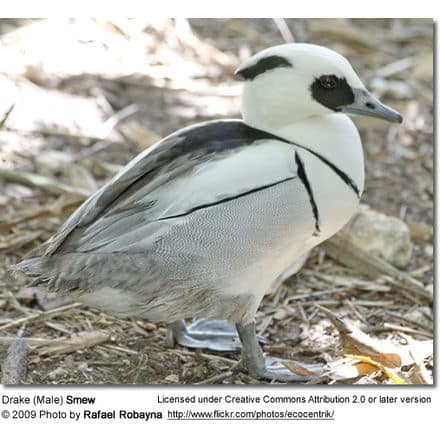
Appearance
The drake Smews, with its ‘cracked ice’ appearance, is unmistakable, and looks very black-and-white in flight. The females and immature males are grey birds with chestnut foreheads and crowns, and can be confused at a distance with the Ruddy Duck; they are often known as “redhead” Smew. It has oval white wing-patches in flight.
The Smew’s bill has a hooked tip and serrated edges, which help it catch fish when it dives for them.
Habitat
This species breeds in the northern taiga of Europe and Asia. It needs trees for breeding. The Smew lives on fish-rich lakes and slow rivers. As a migrant it leaves its breeding areas and winters on sheltered coasts or inland lakes of the Baltic Sea, the Black Sea and northern Germany.
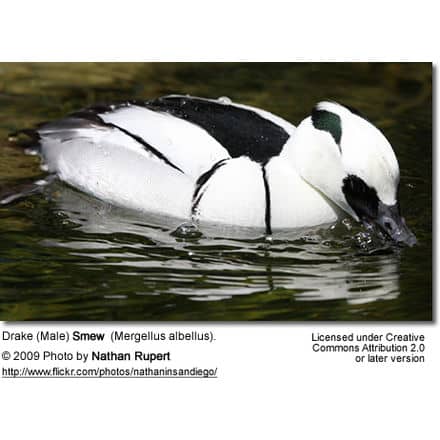

Nesting / Breeding
The Smews breeds in May and lays 6-9 creme-colored eggs. It nests in tree holes, such as old woodpecker nests. It is a shy bird and flushes easily when disturbed.
More Duck Resources
Diet / Feeding:
The Smews uses its bill with a hooked tip and serrated edges to catch fish when it dives for them.
Ducks generally feed on larvae and pupae usually found under rocks, aquatic animals, plant material, seeds, small fish, snails and crabs.
Feeding Ducks …
We all enjoy ducks and many of us offer them food to encourage them to come over and stay around – and it works! Who doesn’t like an easy meal!
However, the foods that we traditionally feed them at local ponds are utterly unsuitable for them and are likely to cause health problems down the road. Also, there may be local laws against feeding this species of bird – so it’s best to check on that rather than facing consequences at a later stage.
- Foods that can be fed to Ducks, Geese and Swans to survive cold winters and remain healthy when food is scarce in their environment.
Please note that feeding ducks and geese makes them dependent on humans for food, which can result in starvation and possibly death when those feedings stop. If you decide to feed them, please limit the quantity to make sure that they maintain their natural ability to forage for food themselves – providing, of course, that natural food sources are available.
Beauty Of Birds strives to maintain accurate and up-to-date information; however, mistakes do happen. If you would like to correct or update any of the information, please contact us. THANK YOU!!!

